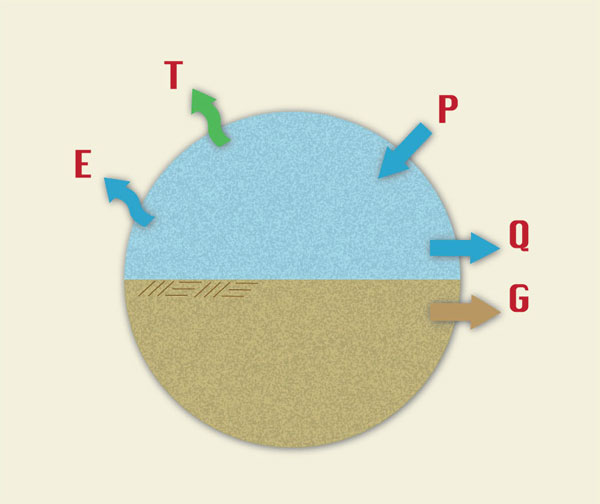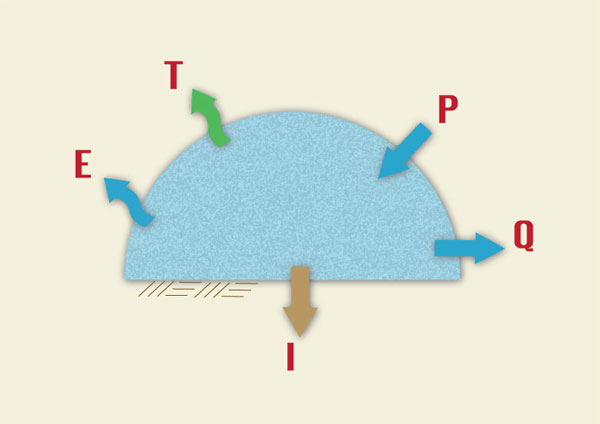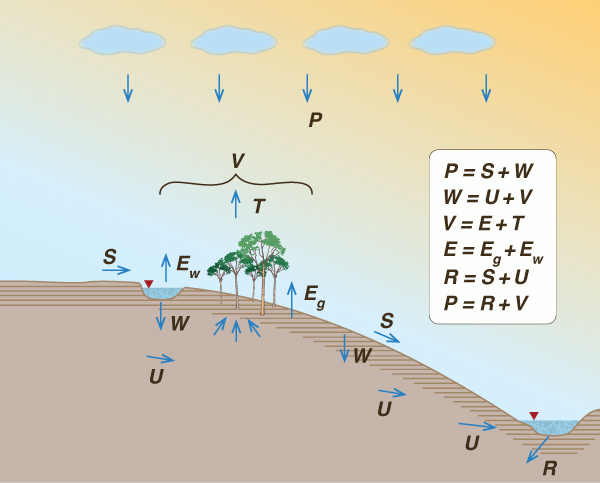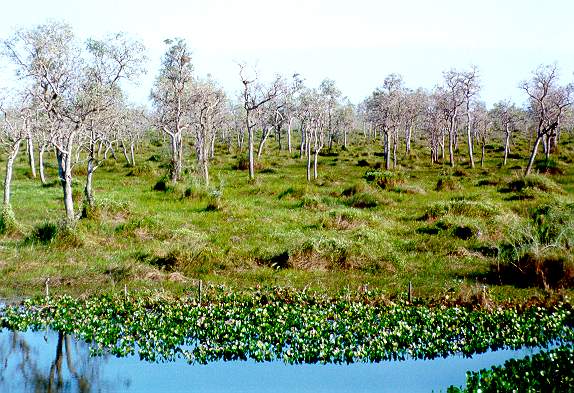|
AND WATER BALANCE |
1. Introduction
The concept of catchment wetting due to L'vovich (1979) enables a better water balance than that possible with conventional methods.
Given precipitation and streamflow data, and using an appropriate baseflow separation technique, L'vovich's method enables the calculation of the matrix of
precipitation/runoff/surface_runoff/baseflow/wetting/vaporization.
This provides a clearer understanding of all the components of the water balance for a given gaged catchment.
2. The water balance
A catchment/watershed/basin water balance is the process by which precipitation is separated into its components.
For the entire system, consisting of surface water and groundwater,
precipitation P separates into four components (Fig. 1):
such that
P = E + T + Q + G (Eq. 1)

|
Fig. 1 Components of precipitation for a complete
catchment water balance.
Deep percolation is the amount of groundwater flow which does not appear as baseflow (G), avoiding the surface waters altogether.
According to L'vovich (1979), on a global basis, deep percolation is usually less than 1.5% of precipitation; therefore, it is
neglected on practical grounds.
For a water balance that excludes groundwater, precipitation separates into four components (Fig. 2):
- evaporation (E),
- evapotranspiration (T),
- surface water runoff (Q), and
- infiltration (I).
| P = E + T + Q + I | (Eq. 2) |

|
Fig. 2 Components of precipitation for a catchment
water balance that excludes groundwater.
A source of complexity in a water balance using Eq. 2 is the unknown fate of
infiltration (Ponce and Shetty, 1995). In fact, infiltration may take one of
several paths:
- Return as evaporation E from lakes, ponds and swamps,
- Return as evapotranspiration T through vegetation, or
- Reach the groundwater table and eventually exfiltrate as baseflow to join the surface waters (Q).
Historically, this double counting has plagued conventional water balance models. It is very difficult to predict the fraction of infiltration that will convert to E, T, or Q.
Depending on the prevailing climate, infiltration is split between [the sum of] evaporation and evapotranspiration and the fraction of Q which originates in baseflow. Yet the calculation of the split is difficult at best. In arid climates, infiltration goes mostly to ET; conversely, in humid climates, infiltration goes mostly to baseflow, i.e., to runoff Q.
The source of the problem is Eq. 2. This equation assumes that infiltration is a sink, independent of E, T or Q, when in fact it is not. This predicament has been resolved by L'vovich (1979), who proposed a linked set of water balance equations to replace Eq. 2.
3. Event and annual water balance
A water balance equation applicable to a storm event is:
| P = Q + L | (Eq. 3) |
in which L = losses, or hydrologic abstractions, defined as
| L = N + D + E + T + I | (Eq. 4) |
in which N = interception by the vegetation canopy, and D = depression storage (Ponce, 1989). Both N and D eventually convert to either E, T, or I.
A water balance equation applicable on an annual basis is:
| P = R + V | (Eq. 5) |
in which
R = runoff, or runoff yield; and V = vaporization, i.e., the sum of all evaporation, including evaporation from ground surface and water bodies, and evapotranspiration from vegetation (Lee, 1970).
4. L'vovich's water balance
According to L'vovich, annual precipitation can be separated into two components:
| P = S + W | (Eq. 6) |
in which S = surface runoff, i.e., the fraction of runoff originating on the land surface, and W = catchment wetting, or simply "wetting," i.e., the fraction of precipitation NOT contributing to surface runoff. In turn, wetting separates into two components:
| W = U + V | (Eq. 7) |
in which U = baseflow, i.e., the fraction of wetting which exfiltrates as the dry-weather flow of streams and rivers, and V = vaporization, i.e., the fraction of wetting returned to the atmosphere as water vapor. Vaporization has two components:
| V = E + T | (Eq. 8) |
in which E = nonproductive evaporation, hereafter referred to as "evaporation," and T = productive evaporation, i.e., that associated with plant transpiration, hereafter "evapotranspiration." Nonproductive evaporation (E) comprises evaporation from nonvegetated areas En and evaporation from water bodies Ew. Thus:
| E = En + Ew | (Eq. 9) |
From Eqs. 5, 6 and 7:
| R = S + U | (Eq. 10) |
The set of Eqs. 5-10 constitute L'vovich's water balance equations (Fig. 3).

|
Fig. 3 Elements of L'vovich's water balance.
The baseflow coefficient, i.e., the fraction of wetting going to baseflow, is:
| Ku = U/W = U/(U + V) | (Eq. 11) |
The runoff coefficient, i.e., the fraction of precipitation going to runoff, is:
| Kr = R/P = R/(R + V) | (Eq. 12) |
5. Methodology
A methodology for catchment water balance has been formulated based on L'vovich's equation set (Eqs. 5-10). The methodology can use either mm or inches, if desired. The step-by-step procedure follows.
- Assemble an array of annual precipitation data P (mm).
- Assemble the corresponding discharge hydrographs [at the mouth of the catchment].
- Using a suitable baseflow separation technique, separate the discharge hydrographs into surface runoff S (m3) and U (m3).
- Divide S and U by catchment area (A) to obtain S (mm) and U (mm).
- With S and U, use Eq. 10 to calculate runoff R (mm).
- With P and S, use Eq. 6 to calculate wetting W (mm).
- With U and W, use Eq. 7 to calculate vaporization V (mm).
- With U and W, use Eq. 11 to calculate the baseflow coefficient Ku.
- With P and R, use Eq. 12 to calculate the runoff coefficient Kr.
Average values of P, R, S, U, W, and V can be used as overall indicators of the catchment water balance.
6. Example
The methodology described here is explained by the following example. Table 1 contains 10 years of data for P (Col. 2) and R (Col. 3).
- P (Col. 2) is obtained from precipitation records.
- R (Col. 3) is obtained from streamgaging records.
- S (Col. 4) and U (Col. 5) are obtained from R (Col. 3) by using hydrograph separation techniques (Ponce, 1989).
- W (Col. 6) is obtained from Eq. 6 [W = P - S] (Col. 6 = Col. 2 - Col. 4).
- V (Col. 7) is obtained from Eq. 7 [V = W - U] ] (Col. 7 = Col. 6 - Col. 5).
- Ku (Col. 8) is obtained from Eq. 11 [Ku = U/W] (Col. 8 = Col. 5 / Col. 6).
- Kr (Col. 9) is obtained from Eq. 12 [Kr = R/P] (Col. 9 = Col. 3 / Col. 2).
| Table 1. Example of L'vovich's water balance. | ||||||||
| Year | P | R | S | U | W | V | Ku | Kr |
| 1 | 2 | 3 | 4 | 5 | 6 | 7 | 8 | 9 |
| 1 | 575 | 110 | 65 | 45 | 510 | 465 | 0.088 | 0.191 |
| 2 | 602 | 125 | 70 | 55 | 532 | 477 | 0.103 | 0.207 |
| 3 | 546 | 112 | 60 | 52 | 486 | 434 | 0.107 | 0.205 |
| 4 | 508 | 105 | 58 | 47 | 450 | 403 | 0.104 | 0.207 |
| 5 | 721 | 148 | 78 | 70 | 643 | 573 | 0.109 | 0.205 |
| 6 | 545 | 126 | 76 | 50 | 469 | 419 | 0.107 | 0.231 |
| 7 | 501 | 120 | 75 | 45 | 426 | 381 | 0.106 | 0.240 |
| 8 | 488 | 99 | 50 | 49 | 438 | 389 | 0.112 | 0.203 |
| 9 | 676 | 134 | 70 | 64 | 606 | 542 | 0.106 | 0.198 |
| 10 | 619 | 145 | 75 | 70 | 544 | 474 | 0.129 | 0.234 |
| Average | 578.1 | 122.4 | 67.7 | 54.7 | 510.4 | 455.7 | 0.107 | 0.212 |
| Note: All units are in mm, except Cols. 8 and 9, which are dimensionless. | ||||||||
The average values [shown in the last row of Table 1] confirm the water balance.
- Eq. 5: P = R + V = 122.4 + 455.7 = 578.1 mm
- Eq. 6: P = S + W = 67.7 + 510.4 = 578.1 mm
- Eq. 7: W = U + V = 54.7 + 455.7 = 510.4 mm
- Eq. 10: R = S + U = 67.7 + 54.7 = 122.4 mm
7. Summary
The set of water balance equations developed by L'vovich are used to formulate a step-by-step procedure
to calculate water balance components for gaged catchments. Significantly, the concept of wetting
sets L'vovich's method apart from conventional water balance models, which do not consider this element.
This results in more consistent water balance modeling.
References
Lee, R., 1970. Theoretical estimates versus forest water yield. Water Resources Research, 6(5), 1327-1334.
L'vovich, M. I., 1979. World water resources and their future. Original in Russian. English translation,
American Geophysical Union, Washington, D.C.
Ponce, V. M., 1989. Engineering Hydrology: Principles and Practices. Pearson Education.
Ponce, V. M., and A. V. Shetty, 1995. A conceptual model of catchment water balance: 1. Formulation and calibration.
Journal of Hydrology, 173(1995), 27-40.
